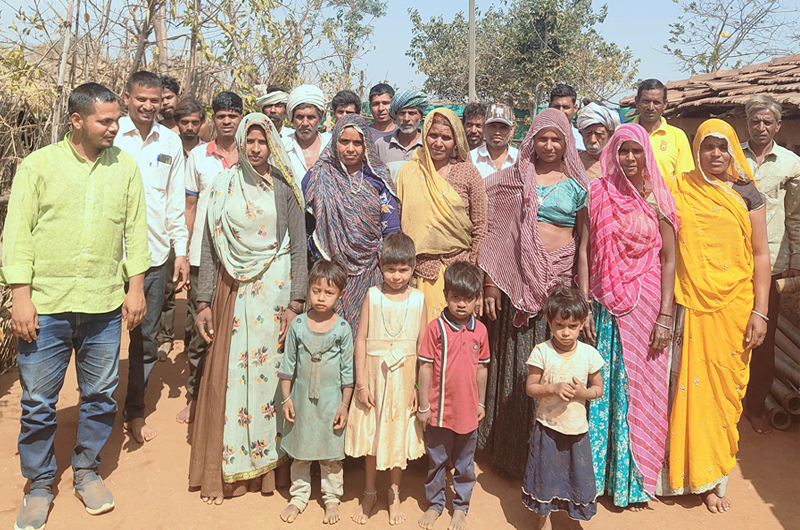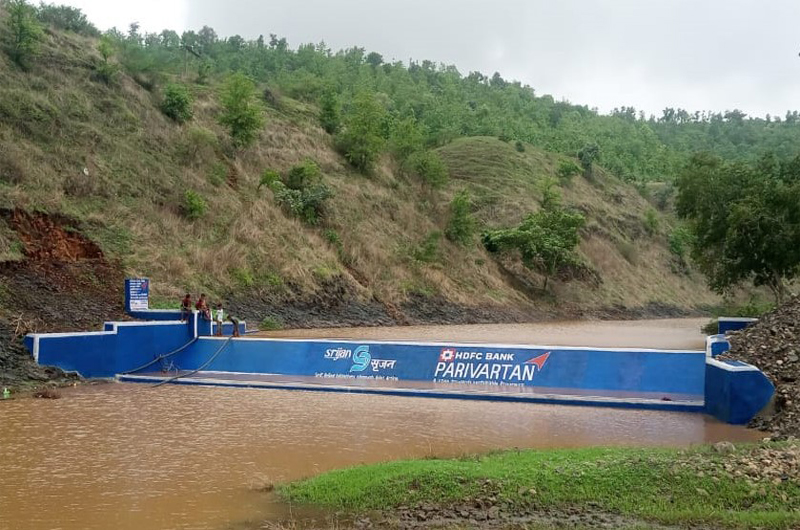Water scarcity has always been a problem in villages in Pratapgarh District’s Suhagpura Block in Rajasthan. Water conservation is most needed for villagers here. Such conservation projects are cost-effective ways of ensuring rural development and welfare; their contribution to enhancing greenery and climate change adaptation is significant, too, says Bharat Dogra. When care is taken to link such benefits to weaker sections, especially women, as SRIJAN is doing, working with women from Meena Tribal Community, then the benefits of such projects become even more significant, he says
Chittodia Village, located in Suhagpura Block of Pratapgarh District in Rajasthan is finding sustenance increasingly difficult because of water scarcity during the first half of the year, before the advent of the monsoon rains. It is not just a matter of shortage of irrigation water, even drinking water is getting increasingly difficult to obtain – for people as well as for farm and dairy animals.
As Gangabai, one of the women gathered at a group meeting, told this writer, there is only one working hand-pump for the scattered settlement of nearly 80 Meena Adivasi (tribal community) households in the remote village. As summer nears, the hand-pump will yield water only haltingly, and queues at the hand pump will increase. Due to the decline in the level of the water table, other hand-pumps do not yield water during summer.
A woman has to walk a kilometre five to six times a day to get drinking water from the hand-pump, Kesarbai added – even in extremely hot weather when waiting time at the tap can get longer. At times, a woman is close to collapsing or even losing consciousness as a result of walking back and forth in the heat, carrying one pitcher, at times two. Water for farm and dairy animals has also to be arranged, and this is obtained from a tanker. The cost – Rs 400. The water lasts for about four days, which means poor households have to spend Rs 100 a day.

With small land holdings and hardly any irrigation possible, more and more young men have been moving to various cities in Rajasthan and Gujarat in search of livelihoods. As jobs are desperately needed, they often accept high-risk and exploitative work. There are stories about young men of the village dying or being disabled, or being cheated of earnings in distant places. During the harvesting season, the women leave before sunrise for more prosperous villages in overloaded tempos to toil all day and return late at night, to earn about Rs 300 a day.
SRIJAN (Self-Reliant Initiatives through Joint Action), a voluntary organisation, has brought a ray of hope among farmers by helping set up orchards and encouraging improved natural farming methods. The organisation took up the work of deepening traditional wells. However, the villagers say clearly that this is not adequate and more needs to be done as quickly as possible to improve access to water.
For example, there is an old anicut (check dam) that needs to be repaired, but the repair and renovation work will amount to almost the cost of a new construction. Trapping rainwater here and conserving it can bring significant relief to the villagers and the costs can be brought down if they can contribute voluntary labour. For about Rs 10 lakh, the villagers estimate, water scarcity can be reduced and conditions made suitable for recharge and moisture levels, both for traditional wells and hand-pumps. The work can be carried out with the cooperation of the villagers, using their knowledge and understanding of local conditions; farm ponds can be created as well.

Har Ghar Jal, the government’s ambitious programme of providing water taps for all village households, has not yet taken off in the villages here, and the villagers say that even if the taps come tomorrow, from where will the water come? It was a similar situation in the next village that this writer visited – Bari Ambeli Village located in the same block. Here, too, there is extreme water scarcity, increasing the burden of women and driving men to migrate. Villagers pointed out to a place at Simaliya nullah (watercourse) where if an anicut is constructed, water scarcity in the village could end considerably. Five other nearby villages would also benefit.
In Kanpuriya Village, water conservation work has made some significant progress, thanks to the work taken up by SRIJAN. New anicuts and bunds have been constructed and damaged ones repaired. Villagers pointed out that as this is a bigger village, the work needs to be extended further to rainwater flows in the upper parts. Though more expensive, but if taken up, the villagers are confident that water scarcity could be reduced to a significant extent. As Premnath Yogi, team leader of SRIJAN asserts, rainfall in normal years in Suhagpura is adequate, the challenge is of conserving enough of the rainwater.
(The writer is a senior freelance journalist and author who has been associated with several social movements and initiatives. He lives in New Delhi.)



 from Webdoux
from Webdoux